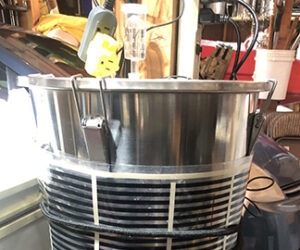Choosing a Fermenter
When it comes to your homebrew, most people will say the most crucial element is taking care of your fermentation, and reasonably so. Although everything involved in making your wort is important, the real stars in the process are the yeast, since they do the true heavy lifting in beer. Honestly, as brewers we’re just servants to the yeast cells, and every master needs his palace, right? There are a lot of fermenting vessels available to homebrewers these days, and making a decision about what’s right for you at any given point in your homebrewing hobby takes some thought. So, lets look at some of the most common homebrewing fermenter choices and narrow down the basics to find out why the material and shape matter, as well as their durability.
Glass
Ah, the old standby! The reason that glass carboys have been the go-to fermentation vessel for so long is simple. Glass is oxygen impermeable, ergo airtight. When a homebrewer is looking for a simple setup, there’s nothing easier than pushing that cooled wort through the top of a glass carboy and squeezing the stopper and airlock into the opening. The stylistic water-cooler jug shape allows for a hearty headspace for healthy fermentation, without an excessive amount of oxygen.
A great thing about glass is the ability to see exactly what stage of fermentation the beer is in. It’s pretty easy to determine how far along your kräusen is when you can see the microbubbles of CO2 floating up or the off-colored foamy peaks. This is also very beneficial if you like brewing sour beers as you can check on the growth and integrity of a pellicle. There is a drawback about being able to see everything, however — if you can see it, light can get to it. As you might enjoy the slightly light-struck, skunky taste of a Mexican lager in a clear bottle, this is not always the type of taste that you want in your own beer. With any glass or light-permeable fermenter, make sure every inch of surface that is exposed to the light is fully covered. Alternatively you may also keep it in a dark closet or fridge, where light will not be able to reach it.
Overall Impression:
Glass is great for homebrewers of every level. Glass carboys tend to average in price between $30-50 a piece, so they won’t break the bank. The number one problem with glass carboys, however, are that they do break very easily, especially when they are full, and also when you are cleaning them as they can be very slippery. Another key flaw is that glass is clear, which can cause light strike in your fermenting beer, so always keep it covered, preferably insulated as well.
Plastic
The second most used fermentation vessel is plastic. There are a variety of plastic fermenters on the market from FastFerment, to Flextank, to MiniBrew conicals, to rectangular Speidels, to the good old fashioned 5-gallon (19-L) brew bucket. The advantage to a 5-gallon (19-L) food-grade brewing bucket is definitely price; they usually sell for around $7 each, including a lid. Some homebrew suppliers carry the same water-jug-style fermenters (small necks) as their glass carboys but made with Polyethylene terephthalate (PET) plastic, which is a cheaper alternative to a great design, and the price averages between $20-30 each.
PET carboys have about the same number of advantages and disadvantages as their glass companions. The biggest difference in favor of PET carboys by far is durability. Glass is easier to break than a giant plastic bottle — when you drop a PET carboy it will bounce and make your heart stop for a second, but still be mostly alright and keep the spill to a minimum. One other advantage PET has over glass is that most PET carboys have a wider opening (a size 10 stopper versus a 6-7), which makes for easier cleaning, racking, and additions, especially when dry hopping with cones. And some PET carboys are now available with wide mouths, such as the FerMonster or Big Mouth Bubbler. PET is not completely oxygen impermeable, however, so they have a disadvantage that glass lacks, and glass is better for doing any long-term bulk storage.
High density polyethylene (HDPE) fermenters like MiniBrew, Flextank, and the FastFerment have been around for quite a while and you might be surprised by how versatile they are. The selling point for them is that all their plastic has been engineered to be a lighter weight, more maneuverable, alternative to glass and stainless at a very reasonable cost. The thickness of the HDPE can minimize, if not eradicate, oxygen permeability unlike PET models. The FastFerment is a simple upside-down teardrop design that allows you to collect your yeast at the bottom, has a thermowell for your thermometer, and the ability to have a tasting port as well. The MiniBrew fermenters have a conical design, can be ordered with a thermowell, have a racking port as well as a bottom valve for filling and emptying.
Flextank offers their Tankenstein line for brewers. These are fitted with a single ball valve port, but are not conical and most resemble carboy shape of the HDPE fermenters. All three HDPE manufacturers offer wide mouth access on their units.
Scratches are by far the biggest challenge for any plastic fermenting vessel because even with the most intensive scrubbing, cleaning, and sanitizing, bacteria will breed like mad in that tiny crevice. Plastic fermenters in general are a great alternative because of cost, but a rule to brew by is that once it has an irreparable scratch, it’s done. Buckets aren’t too expensive but alternative plastic fermenters, such as FastFerments, MiniBrew conicals, and Flextanks on the other hand, cost a bit more than you might feel comfortable about for a quick toss in the garbage after the first scratch appears. A vessel with a clean space inside but a scratch or two on the outside are fine since the beer isn’t touching the outer surface. However, sometimes it’s better to err on the side of caution when it comes to sanitation. Check your plastic fermenters regularly for scratches!
Overall Impression:
Plastic fermenters are great for most homebrewers. If you are using buckets, your beers should come out fine as long as you always thoroughly inspect your vessels and make sure the seals on the lid and airlocks are always tight and well maintained. Buckets are fairly inexpensive, but always make sure they are food grade. The same rules apply to other plastic fermenters. Plastic has been used to ferment many things, and with the right care you can get the same finished product as you would with any other type of material. On the cautious side, those who are considering mixed fermentations, or long periods of time in the vessel after primary fermentation, should try to shy away from PET plastic because it is still a permeable material. Although this usually won’t affect most beers during fermentation with Saccharomyces, acetic acid producing strains of bacteria, such as Acetobacter, will go bloodlust on any amount of oxygen, possibly causing an acid bomb, instead of an enjoyable (palatable) tartness.
Stainless
So here’s the dividing line between the occasional hobby brewer, and the guys who go to work to afford to brew a lot. Stainless steel conicals are the holy shrine of a homebrewer’s setup. Producers tend to pull out all the bells and whistles (or at least have the options) with these types of fermenters that all homebrewers dream of. Stainless steel is the most sanitary material you can get when it comes to fermentation. Although owning a stainless steel fermenter is many a brewer’s fantasy, like any fantasy, they don’t come cheap. Most range from $500-4,000 for a single fermenter depending on the capacity and how many of the extra bells and whistles you want. There are some stainless bucket-type fermenters on the market, as well as Anvil’s Ferment in a Kettle, that also functions as the brew kettle — both types available for a somewhat smaller pricetag.
Some advantages of having a stainless steel fermentation vessel, over plastic or glass, are (1) breakage is fairly difficult to do, (2) scratches are harder to get, but not impossible, and in experienced hands can be buffed out, and (3) usually they’re good for quite a few years. Some definite disadvantages of stainless vessels are that they are expensive, and if you get one with threaded outlets you have to worry more about sanitation versus tri-clamp fittings. When buying a stainless steel vessel for fermentation, you’re already forking out a decent sum of money for what many would assume is sanitation purposes. With that in mind while buying a stainless steel vessel, the best match is to choose tri-clamp fittings as they are easy to clean, easy to take apart, and far more sanitary than threaded fittings and outlets.
The biggest functional difference between the conical shape and flat-bottom fermenters is yeast plain and simple. A conical allows the yeast to flocculate and collect in the cone, making it a great option for those brewers looking to re-pitch or cultivate their yeast. The conical shape also allows you to separate the yeast from the beer without racking into a secondary vessel.
A piece of advice I always give to people looking into any stainless steel vessel is that if the manufacturer has specially built in an insulation layer, please consult them before your purchase about adding any additional ports after your purchase. In some cases this has led people to render their vessel useless and thus be out hundreds of dollars.
Overall impression:
Stainless steel is a great choice for advanced homebrewers. If you have the disposable cash to afford a stainless steel fermenter by all means I recommend it for cleaning and sanitation alone. Although beginner to intermediate brewers are more than recommended to invest in stainless fermenters, experience and finances can have a big impact on this decision. For those looking into temperature control, most manufacturers have the extra equipment to make that possible as well.
Barrels
Barrels are not a new way of fermenting beer, but they have become a more popular option for homebrewers with a barrel to spare. There are not many professional breweries even using this method, mostly because on a commercial scale the risks are too great and stainless steel works well. With barrels there is a bit of room for error in the sense that barrels are a kind of living piece of equipment in the brewery — they become affected by their environment, and microbes love all the nooks and crannies. Because of this reason, many commercial brewers shy away from primary fermentation within the barrel. But, with basic sanitation techniques and a willingness to experiment, it is highly possible to produce clean beers with a barrel fermentation.
Choosing the wood for your barrel is the first step. French, American, and Hungarian are the most popular varieties. The next step is the toast. Medium toast is the most widely made for wine, is available in all three types of oak, and is also the toast level that you’re probably getting if you buy oak chips from a homebrew store. Char is different and is usually only available in American oak, and it will give you a light, whiskey-like, vanilla flavor fairly immediate. Toast is much lighter, smooth, and will give you an oaky finish and leathery components, closer to the flavor you’ll be looking for if doing English beers. Char will be much more robust in flavor contribution, giving an immediate vanilla and roasty flavor. Depending on the size and type of oak, prices for barrels range between $50 for a small used barrel all the way up to $1,500 for a 60-gallon (228-L) brand-new French oak model.
Jim Crooks, Master Blender at Firestone Walker Brewing Co. in Paso Robles, California, says the method used for their Union beer is to let the beer ferment in stainless steel for about 24 hours, then rack it into barrels for the rest of fermentation. Sanitation is the key though. He says:
“We clean and reuse the barrels multiple times; up to 40 turns of a Union barrel is not uncommon if the barrel continues to produce un-infected product. The beer in the barrel is tested every week and plated on micro medias looking for beer spoilers. If a new barrel is contaminated with a beer spoiler, even on it’s first use, it is replaced. Our policy is to remove any barrel from the Union immediately if that barrel shows micro contamination with specifically a beer spoiler . . . Make sure you clean your barrels before using them. If looking to use a used wine barrel make sure that the barrel has been cared for and is rinsed, sulfured and free of any VA (volatile acidity).”
Another note about barrels: New oak barrels add lots of oak character that is usually much more than many beers can handle. At Firestone Walker, for example, they have a range of ages in their set of Unions and this blends new and used to temper the contribution from new barrels.
Overall Impression:
Barrels are an interesting way to ferment, but they are not recommended for inexperienced homebrewers. Barrels are expensive and need quite a bit more work to maintain than most homebrewers anticipate. If you’re making “clean” beer, this is most likely the worst option for you. Exceptions arise, such as making a traditional (as in 1800s traditional) beer, specifically English or Belgian, but they are only recommended to those with a large amount of brewing, and preferably barrel care, experience. The largest key to producing clean beer is keeping the barrel sanitary and free from beer spoiling growth of any kind.
Final Thoughts
Glass is the most cost effective, sanitary, and non-permeable choice of fermenter, as long as you are careful to avoid breakage. Stainless steel is top notch as well, but the cost can always be a huge factor. Plastic is a great choice, but can have some drawbacks due to oxygen permeability (depending on the type of plastic and wall density) and its tendency to scratch. Barrels are great for aging and sours in general, but clean beer fermentations can be very tricky without the right lab equipment for catching spoilage early. Choose what’s right for your setup, and have fun homebrewing!




